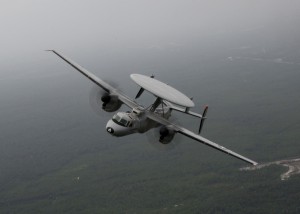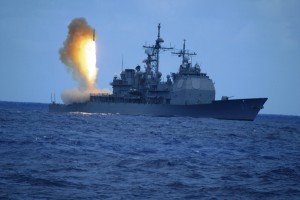 I got to talk with Navy Times scribe Andrew Tilghman the other day about the prospects of extending the reach of the Aegis system by using sensor nodes that are less expensive than, well, other exposed and forward-deployed Aegis ships.
I got to talk with Navy Times scribe Andrew Tilghman the other day about the prospects of extending the reach of the Aegis system by using sensor nodes that are less expensive than, well, other exposed and forward-deployed Aegis ships.
After a delightful conversation, Andrew generated a story for the old-school May 25 press issue of Navy Times, entitled “Program teams E-2Ds, Aegis to protect carrier strike groups” (no link, sorry). I have a few quotes in it, and wanted to add a little context.
My sense is that if America can enlist cheaper platforms to serve as forward sensors for Aegis–and pass collected information quickly, reliably and cheaply to Aegis combatants, then America will have materially increased the capability of our Aegis-heavy fleet (until somebody comes up with a technical threat that sends the Aegis system into block obsolescence–a frighting prospect, no?).
But the lesson is this–cheaper forward sensors give the Aegis combatant more time to respond to fast-moving threats and keeps America’s Big Blue Water Combatants (BBWC) out of harm’s way. In addition, adding new sensors makes Aegis harder to defeat.
The E-2D Advanced Hawkeye takes the Hawkeye’s traditional airborne combat controller role and adds in a potential BMD sensing and cueing capability. Additional input from extra sensors (say from E-2D-like radar on a balloon tethered to an LCS, JHSV or T-AKE–or just embarked upon a UAV), Aegis suddenly becomes a real, honest-to-goodness blue-water missile-defender for an entire region.
With strong multi-platform, multi-axis sensor support, the case for an Arsenal Ship–a specialized non-multirole “at-sea” bastion BMD ship–gets stronger, too.
Can it be done? Sure. Can it be done cheaply? And reliably? Err…well, just how “plug and play” is Aegis right now? Can the Aegis system absorb–cheaply and easily-additional sensor inputs? Here’s what I told Navy Times:
But doubts remain about the technology. The new Hawkeye will test the Aegis system and its ability to adapt to an increasingly integrated battlefield.
“Is Aegis actually plug and play? That is the question,” said Craig Hooper, a national security expert and defense consultant in San Francisco. The integration will require extensive software development inside the Aegis system, Hooper said.
The Hawkeye could provide a potentially vital backup protection for a strike group, said Will Dossel, a retired captain and E-2C naval flight officer.
Current technology allows the Aegis system to be cued and fired based on signal intelligence relayed from s
atellites. But a sophisticated enemy could temporarily disable the satellite signals and create a brief window of vulnerability for strike group, Dossel said.
A Hawkeye might be able to protect the strike group despite a satellite blackout.
“This might be able to provide that kind of organic cueing,” Dossel said.
Testing of the integrated fires system will begin in 2012 and will continue until the new Hawkeye is fully operational in 2015.
It may prove to be a monumental advancement for the Aegis system.
“It’s a big question for a decidedly non-plug-and-play system,” Hooper said. “If you are able to generate a node that could input targeting data to an Aegis system, reliably and cheaply, that would be a big deal. Be it a low-level threat like a Hezbollah-type firing of a cruise missile, or when the big red peril comes rising over the western Pacific.”
Aviators most familiar with the new plane say the missile-defense capability might be just the beginning of new missions for the Hawkeye community.
 My question is who can the Advanced Hawkeye talk to? Everybody? Aegis BMD 3.6.1? Aegis BMD 4.0.1? Or planned Aegis BMD 5.0–the future open architecture plug n’ play, er, um, thing? America is discovering that the failure to develop a true open-architecture combat control system leads to substantial costs–in time, hull availability and money. Look how long it’s taking to upgrade Aegis vessels–this coming from Dan
My question is who can the Advanced Hawkeye talk to? Everybody? Aegis BMD 3.6.1? Aegis BMD 4.0.1? Or planned Aegis BMD 5.0–the future open architecture plug n’ play, er, um, thing? America is discovering that the failure to develop a true open-architecture combat control system leads to substantial costs–in time, hull availability and money. Look how long it’s taking to upgrade Aegis vessels–this coming from Dan
Taylor’s recent story from Inside the Navy (again, no link, sorry):
The upgrades are increasingly expensive and time-consuming, however. Aegis BMD 3.6.1 is about $15 million per ship and procurement generally requires an 18-month lead time, and the ship is not deployable for three months while the system is installed and certified. The 4.0.1 upgrade, however, has a procurement lead time of 22 months and requires the ship to be docked for six-and-a-half months for training, certification and testing. It costs at least $45 million per ship, potentially more.
Finally, procurement lead time is 24 months for the 5.0 system and all the installation, testing and simulation add up to two years that the ship will have to be docked, although Mabus predicts in the report that that time frame will decrease with follow-on ships.
That’s a long time for an Aegis vessel to sit around–for the 62 DDG-51s, that’s 124 years of unavailability. While the ultimate goal is a worthy one, it’s quite the price for a shrinking Navy to pay–a tax for not going to open architecture earlier.

{ 3 comments }
The decision on closed and open architecture was, conceptually, made years ago. The bites in our collective *ss^s have been getting bigger and bigger as we’ve come to recognize the … ‘issues’ with closed architectures.
http://xkcd.com/743/
You’re correct. It would have been nice to get some info on how much time has been shaved off the initial bmd instals. That’d be a good guide to use as a model…
If the first of a new generation (Aegis BMD 5.0) will take two years, is it fair to extrapolate that same timeline to all of the following ships? Consider for a moment that the timeline includes the initial certification of the design. Certifying that a follow-on instance of the same design should take considerably less time.
Comments on this entry are closed.